#pv monitoring solutions
Explore tagged Tumblr posts
Note
(Ooc: rubbing my hands like an evil little fly trying to cook up a way to bring Vani into this… also rip medical staff … my projection is going to make their life harder… blame recluse)
**the temperature monitors attached to the dragon begin to beep as they recross the threshold, a sickly pallor and flush appearing on the sedated dragon’s face. They’ve developed a fever. Seems the amount of time they spent without magic, and melting, made them develop an infection. They’re sick.** ha… ha…. (Panting) — Rime Dragon Cookie - aka bird anon
ooc: BRING PV INTO THISSS
staff: get some of that solution used for his majesty.
Another staff: I'll get more ice.
tired staff: ugghhhh they're sick too.... pure vanilla cookie needs to fucking pay me more. *Checking vitals*
more staff: *doing other stuff to help stabilise their condition*
#Medical staff members (NPC)#cookie run au#crk au#cookie run kingdom au#cookie run rp#crk rp#crk roleplay#rp blog#cookie run roleplay
3 notes
·
View notes
Text
Switchgear for Solar and Wind Projects in Bahrain: What You Need to Know
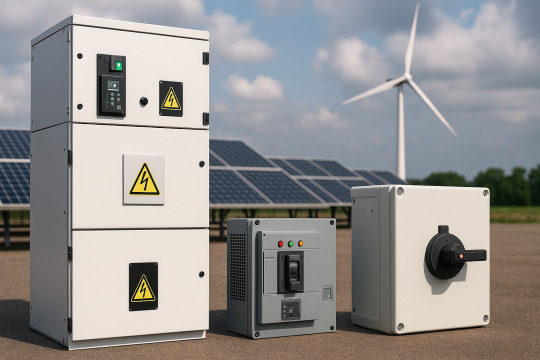
As Bahrain intensifies its commitment to renewable energy, solar and wind power projects are gaining momentum across the Kingdom. The nation’s Vision 2030 emphasizes sustainable growth, and this includes an ambitious target of generating 10% of electricity from renewable sources by 2035. As developers and investors gear up for this energy transition, one component plays a critical role in ensuring system safety, reliability, and efficiency — switchgear.
In this article, we explore why switchgear is crucial in solar and wind power systems, the specific requirements in Bahrain, and how to choose the right solution for your renewable energy project.
What is Switchgear and Why Does it Matter?
Switchgear is a general term covering a wide range of electrical devices used to isolate, protect, and control electrical circuits. It includes circuit breakers, fuses, relays, disconnectors, and load break switches.
In renewable energy systems, switchgear ensures:
· Safe disconnection of faulty or overloaded circuits
· Protection against overcurrent, short-circuit, and earth faults
· Efficient control and monitoring of power flow
· Coordination with grid and off-grid systems
Renewable Energy Growth in Bahrain
Bahrain’s sunny climate and strong coastal winds make it an ideal location for solar PV and wind power installations. Recent government initiatives — such as the Net Metering Scheme, Tendered Renewable Projects, and Green Building Regulations — are creating opportunities for both utility-scale and distributed renewable energy systems.
However, environmental factors such as high temperatures, humidity, and dust pose challenges for electrical equipment, particularly in outdoor solar and wind sites. This makes the right choice of switchgear even more important.
Key Switchgear Considerations for Solar Projects
In photovoltaic (PV) installations, switchgear must be compatible with DC (direct current) as well as AC (alternating current) systems. Here are specific points to consider:
1. DC Switchgear for PV Arrays
· DC Disconnectors: Isolate individual PV strings for maintenance or emergency shutdowns.
· DC Fuses and Circuit Breakers: Protect cables and components from over currents.
· String Combiner Boxes: Integrate multiple PV strings and incorporate protective devices.
2. AC Switchgear for Inverter Output
· Low-Voltage Circuit Breakers (AC): Used between inverters and transformers or grid connection points.
· Load Break Switches: Offer safe disconnection under load conditions.
· Metering and Monitoring Units: Allow real-time tracking of power output and faults.
3. Environmental Protection
· Use switchgear with IP65-rated enclosures to protect against dust and water ingress.
· UV-resistant materials are vital for long-term durability under the Bahraini sun.
Switchgear in Wind Energy Systems
Wind energy systems involve varying voltage levels and require robust protection due to fluctuating wind speeds and mechanical loading. Key switchgear elements include:
1. Medium Voltage Switchgear
· Used for interconnection between wind turbines and step-up transformers.
· SF6 or Vacuum Circuit Breakers: Provide arc quenching and insulation under high voltage.
2. High-Speed Protection
· Wind turbines are sensitive to voltage dips and transients. Fast-acting relays and breakers prevent equipment damage.
· Reactive power control and grid fault detection are integrated into switchgear assemblies.
3. Compact, Modular Designs
· Space constraints inside turbine towers or nacelles demand compact switchgear solutions with modular layouts.
Bahrain-Specific Compliance and Standards
To ensure your switchgear meets local utility and regulatory requirements, consider the following:
· EWA (Electricity & Water Authority) Requirements: All grid-connected systems must comply with EWA’s interconnection standards, including protection schemes and disconnection devices.
· IEC Standards: Switchgear must comply with relevant IEC 60947 (low-voltage switchgear) and IEC 62271 (high-voltage switchgear) guidelines.
· Thermal Rating and Ambient Temperature: Switchgear should be rated for continuous operation at temperatures up to 50°C, common in Bahraini summers.
Choosing the Right Switchgear Partner
A successful renewable energy project hinges on choosing a reliable switchgear partner. Look for:
· Local experience in Bahraini environmental and regulatory conditions
· Customizable solutions for both rooftop and utility-scale systems
· After-sales support including spares, maintenance, and system upgrades
· Smart switchgear with digital monitoring for preventive maintenance and remote control
Future Trends in Switchgear for Renewables
As solar and wind systems grow more advanced, so does switchgear technology. Key trends include:
· Digital Switchgear: Real-time monitoring, predictive maintenance, and IoT integration
· Arc-Resistant Designs: Enhanced safety for personnel in substations
· Eco-Friendly Alternatives to SF6: Adoption of green gases and air-insulated switchgear
· Hybrid AC/DC Systems: With growing battery storage and hybrid plants, switchgear must handle both current types seamlessly
Conclusion
Whether you’re planning a rooftop PV installation or a wind farm in Bahrain, your switchgear solution must be robust, compliant, and tailored to the region’s unique challenges. By choosing the right switchgear system, you ensure operational efficiency, regulatory compliance, and long-term safety.
If you’re looking for expert advice or need help selecting switchgear for your solar or wind project in Bahrain, our team is here to help. Contact us today for tailored solutions that power your progress sustainably.
#electrical engineers#electrical supplies#switchgear#electrical equipment#911 abc#bahrain25#arcane#artists on tumblr#batman#cats of tumblr
3 notes
·
View notes
Text
Future of Energy Harvesting System Market: Innovations & Opportunities
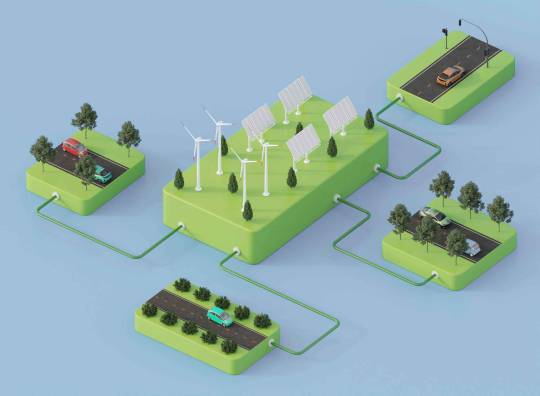
Executive Summary: A Transformational Shift in Energy Utilization
The global energy landscape is undergoing a revolutionary transformation, driven by the rising need for sustainable power sources. Energy Harvesting System Market, which convert ambient energy into electrical energy, are at the forefront of this transition. From reducing battery dependency to enabling long-lasting power for low-energy electronics, energy harvesting is not just an innovation—it is the future of decentralized energy systems. This comprehensive analysis explores market trends, technological advancements, regional dynamics, and competitive strategies shaping the Energy Harvesting System market from 2024 to 2032.
Request Sample Report PDF (including TOC, Graphs & Tables): https://www.statsandresearch.com/request-sample/18569-global-energy-harvesting-system-market
Energy Harvesting System Market Overview: Growth Fueled by Smart Technologies and IoT
The Energy Harvesting System market is experiencing accelerated growth, propelled by the exponential expansion of the Internet of Things (IoT), wearable technology, smart buildings, and industrial automation. As power efficiency becomes a paramount concern, EHS solutions are poised to dominate in areas where battery replacement is infeasible or undesirable.
Key Energy Harvesting System Market Drivers
Escalating demand for wireless sensor networks in industrial automation
Increasing adoption of self-powered wearable electronics
Expansion of smart city infrastructure worldwide
Rising awareness of environmental sustainability
Technological breakthroughs in micro-energy sources
Get up to 30%-40% Discount: https://www.statsandresearch.com/check-discount/18569-global-energy-harvesting-system-market
Energy Harvesting System Market Segmentation by Technology Type
Light Energy Harvesting
Light—especially solar—is the most widely adopted energy harvesting source. Modern photovoltaic (PV) cells integrated into smart sensors enable continuous data transmission, particularly in outdoor and well-lit indoor environments.
Vibration Energy Harvesting
Using piezoelectric, electrostatic, and electromagnetic technologies, vibration-based systems extract energy from motion. This segment is gaining traction in transportation, manufacturing equipment, and infrastructure monitoring.
RF (Radio Frequency) Energy Harvesting
RF harvesting utilizes ambient wireless signals—Wi-Fi, cellular, and TV broadcasts—as power sources. Though it generates smaller outputs, it is ideal for ultra-low-power IoT devices.
Thermal Energy Harvesting
Thermoelectric generators convert heat gradients into electricity. These are valuable in industrial settings with consistent thermal waste, such as oil & gas and automotive sectors.
Application Analysis: Sector-Wise Adoption and Impact
Industrial Applications
The industrial sector is the largest and fastest-growing segment due to widespread use in condition monitoring, predictive maintenance, and machine-to-machine communication. Energy harvesting minimizes downtime and reduces operational costs.
Household Applications
Smart home systems—thermostats, lighting, door locks—are increasingly powered by ambient sources. Energy harvesting eliminates wiring complexity, enhances aesthetics, and prolongs product life.
Commercial Applications
In commercial buildings, EHS supports lighting controls, HVAC automation, and occupancy sensors, driving energy efficiency and compliance with green building standards.
Regional Insights: Growth Hubs and Strategic Opportunities
North America
With robust investments in smart infrastructure and industrial automation, North America leads in technological adoption. The U.S. is a prime consumer due to strong regulatory incentives and innovation hubs.
Europe
Driven by stringent environmental policies and strong R&D investment, Europe showcases rapid uptake in energy harvesting for both consumer electronics and automotive applications.
Asia-Pacific
China, Japan, and India are emerging as manufacturing powerhouses for EHS components. Government-led smart city projects and massive IoT deployment in the region bolster demand.
Competitive Landscape: Strategic Initiatives and Market Leadership
The EHS market is moderately consolidated, with innovation-focused players driving growth through partnerships, acquisitions, and proprietary technology.
Leading Energy Harvesting System Market Participants
Texas Instruments – Renowned for ultra-low-power microcontrollers and energy management ICs.
STMicroelectronics – Offers piezoelectric and thermoelectric energy harvesting kits.
Honeywell International – Specializes in industrial-grade vibration and thermal harvesters.
EnOcean GmbH – Pioneer in wireless energy harvesting solutions for building automation.
Powercast Corporation – Dominant in RF-based harvesting for commercial and consumer applications.
Investment and R&D Trends
Significant capital is being invested in miniaturization, integration, and wireless communication protocols. R&D efforts focus on increasing conversion efficiency, hybrid harvesting systems, and AI-integrated energy management.
Strategic Recommendations for Stakeholders
OEMs: Prioritize integration of hybrid harvesting systems to enhance device versatility.
Investors: Focus on companies offering scalable platforms for IoT and industrial solutions.
Policymakers: Create incentive structures to accelerate deployment in infrastructure and transportation.
Startups: Innovate in niche areas such as biomedical implants and agricultural sensors.
Energy Harvesting System Market Forecast: 2024–2032
The global Energy Harvesting System market is projected to grow at a compound annual growth rate (CAGR) exceeding 10%, reaching a multi-billion-dollar valuation by 2032. The proliferation of wireless electronics and growing sustainability mandates will drive this robust expansion.
Future Outlook: Toward a Battery-Free Ecosystem
Energy harvesting is redefining how devices interact with their environment. By enabling continuous, maintenance-free operation, EHS is laying the groundwork for a future where billions of interconnected devices operate independently of batteries. The confluence of AI, 5G, and ambient energy will define the next phase of ubiquitous computing.
Purchase Exclusive Report: https://www.statsandresearch.com/enquire-before/18569-global-energy-harvesting-system-market
Conclusion
We are at the cusp of a paradigm shift in power generation for low-energy electronics. Energy harvesting is no longer a niche technology—it is an essential enabler of the sustainable, connected future. By adopting and investing in next-generation EHS, industries and governments can future-proof operations, enhance resilience, and lead in the transition toward net-zero energy infrastructure.
Our Services:
On-Demand Reports: https://www.statsandresearch.com/on-demand-reports
Subscription Plans: https://www.statsandresearch.com/subscription-plans
Consulting Services: https://www.statsandresearch.com/consulting-services
ESG Solutions: https://www.statsandresearch.com/esg-solutions
Contact Us:
Stats and Research
Email: [email protected]
Phone: +91 8530698844
Website: https://www.statsandresearch.com
1 note
·
View note
Text
Top Commercial Solar Panel Installers in Leicester & Midlands
As more businesses seek reliable ways to reduce energy bills and lower their carbon footprint, demand for commercial solar installations is on the rise across the UK. In Leicester and the Midlands, companies of all sizes are investing in business solar panel installation as a long-term energy solution. Choosing the right commercial solar panel installers is crucial to achieving the best results. This blog highlights what to look for in a trusted provider and lists the top options in the region.
1. Why Businesses Are Choosing Solar in the Midlands
Switching to a commercial solar panel system is a smart move for any business that wants to cut costs and take control of its energy use. Electricity prices are unpredictable, and solar power helps businesses become more self-sufficient.
With incentives like the Smart Export Guarantee and falling panel costs, solar power commercial installations have never been more affordable. In addition to savings, using clean energy also supports sustainability goals and enhances your company's image.
Whether you run a warehouse, factory, office, or retail site, a properly installed commercial solar power system can start generating returns from day one
2. What Makes a Great Commercial Solar Installer?
When searching for commercial solar installations companies, it’s important to go beyond just price. A reliable installer will offer full project support – from the first site visit to post-installation monitoring.
Here’s what to look for:
Experience: Choose a company with a strong track record in industrial solar panel installation and commercial projects.
Custom Solutions: Every business is different. The installer should offer tailored commercial solar panel systems that meet your exact needs.
Certifications: Look for MCS and RECC accreditations, which show a commitment to quality and consumer protection.
Aftercare: Reliable commercial solar panel installers provide long-term support, maintenance, and system upgrades.
It’s also helpful to check customer reviews and ask for examples of completed commercial solar installations similar to your business.
3. Leicester’s Leading Solar Installation Companies
Leicester is home to a number of trusted commercial solar panel installer options. These companies specialise in helping businesses across the Midlands transition to solar energy:
1. Geo Green Power Well-known for their work across commercial and industrial sectors, Geo Green Power designs and installs high-performing commercial solar panel systems. They also offer battery storage and EV charging solutions.
2. Spirit Energy Though based slightly further south, Spirit Energy has served several clients in the Midlands. Their team works on large-scale commercial solar installations and delivers smart energy systems backed by performance monitoring.
3. Custom Solar Custom Solar is one of the UK’s top commercial solar PV installers, with a strong presence in Leicester and nearby regions. They handle complex installations for logistics centres, manufacturers, and councils.
These companies understand the local business environment and regulatory landscape, making them ideal choices for solar panel installation Leicester and the wider Midlands area.
4. Making the Switch to Solar: What to Expect
Once you choose your commercial solar panel installer, the installation process typically includes:
Site Assessment: The installer will review your building and energy usage to determine the best solution.
System Design: A custom commercial solar power system is created based on your needs and space.
Installation: Panels, inverters, and safety equipment are installed, usually with little disruption to your operations.
Grid Connection: Your system is connected to the grid so you can use and export power.
Monitoring: Ongoing system tracking ensures performance and identifies any maintenance needs.
Modern systems are low-maintenance and designed to last over 25 years, meaning your business solar panel installation will keep saving you money long-term.
Conclusion With the right partner, your switch to solar can be smooth, rewarding, and cost-effective. From lowering your energy bills to supporting your green goals, a professional commercial solar installation is one of the best investments a business can make.Are you considering solar panel installation Leicester or elsewhere in the Midlands? Have you already installed a commercial solar panel system? Share your thoughts or questions in the comments – we’d love to hear your experience!
0 notes
Text
Commercial Rooftop Solar Panel in Raipur – Smart Energy Solutions by Techno Sun Energy
In today’s fast-paced business world, reducing operational costs while adopting sustainable practices is crucial. A growing number of commercial establishments in Raipur, Chhattisgarh are turning to commercial rooftop solar panels as a reliable, eco-friendly, and cost-effective energy solution.
At Techno Sun Energy, we specialize in commercial solar rooftop systems that help businesses take control of their power consumption, save significantly on electricity bills, and demonstrate environmental leadership.
What Are Commercial Rooftop Solar Panels?
Commercial Rooftop Solar Panel in Raipur are solar photovoltaic (PV) systems installed on the rooftops of commercial buildings—such as offices, malls, warehouses, factories, schools, hospitals, and hotels. These systems capture sunlight and convert it into usable electricity, significantly reducing reliance on grid electricity and diesel generators.
In a city like Raipur, with high solar irradiance and rising commercial power tariffs, rooftop solar is not just an alternative—it’s an advantage.
Top Benefits of Installing Commercial Rooftop Solar Panels in Raipur
✅ Significant Cost Savings
Solar energy can cut your commercial electricity bills by up to 60–90%, especially during peak daylight hours when consumption is highest.
✅ Tax Benefits and Accelerated Depreciation
Businesses can benefit from accelerated depreciation under Section 32 of the Income Tax Act—up to 40%—making solar a smart investment with quick ROI.
✅ Net Metering Facility
Feed excess energy back into the grid and receive credits on your electricity bill through Chhattisgarh State Electricity Regulatory Commission’s net metering policy.
✅ Improved Brand Image
Going solar highlights your company’s commitment to sustainability and corporate social responsibility—enhancing your brand reputation.
✅ Long-Term Investment
With a system lifespan of 25+ years and low maintenance, solar ensures long-term energy security and operational efficiency.
Who Can Benefit from Commercial Solar Rooftops in Raipur?
Corporate Offices
Manufacturing Units & MSMEs
Shopping Malls & Showrooms
Educational Institutions
Hospitals & Clinics
Hotels & Banquets
Supermarkets & Cold Storage Facilities
Whether your commercial property is in Pandri, Tatibandh, VIP Road, Bhanpuri, or Mandir Hasaud, Techno Sun Energy can design a solar solution tailored to your roof and energy requirements.
Why Choose Techno Sun Energy for Commercial Solar in Raipur?
Established in 2017, Techno Sun Energy is one of Raipur’s leading solar EPC companies, offering end-to-end commercial rooftop solar solutions.
Turnkey Projects – From site survey to net metering and commissioning Quality Products – We use premium Tier-1 panels, inverters, and mounting structures Custom Design – Systems sized based on your load profile and roof availability Subsidy & Tax Assistance – Support with documentation for financial benefits Expert Team – Certified engineers and skilled installers for precision work Performance Monitoring – Real-time tracking through remote monitoring apps
How Our Commercial Solar Process Works
Site Inspection & Energy Audit
Custom Design & ROI Proposal
Installation & Safety Testing
Net Metering Setup
Commissioning & Handover
After-Sales Service & Maintenance
We ensure minimal disruption to your business during installation and maintain high safety standards.
Solar Panel Options for Commercial Clients
10 kW to 500 kW systems depending on roof space and load
On-Grid Systems for businesses with daytime consumption
Hybrid Systems with battery backup for uninterrupted power
Bifacial and Mono-PERC Panels for higher efficiency
Power Your Business with Techno Sun Energy
A commercial rooftop solar installation is more than just a cost-saving initiative—it’s a smart investment in the future of your business. At Techno Sun Energy, we are committed to helping Raipur’s commercial sector harness the full potential of solar energy.
Contact us today for a free energy assessment and customized quote. Let your rooftop start generating returns—with solar!
#Commercial Rooftop Solar Panel in Raipur#commercial solar power system#commercial solar panel installation#solar power for business
0 notes
Text
Lux Solar Strengthens Florida’s Clean Energy Grid with State-wide Expansion and Advanced Solar Technologies

MIAMI, FL – Lux Solar, a premier solar energy company and equipment supplier headquartered in Miami, officially announces its accelerated expansion across Florida, positioning itself as a driving force in the Sunshine State’s renewable energy revolution.
As energy costs surge and environmental concerns grow, Lux Solar emerges as a beacon of innovation and reliability. The company now extends its reach beyond Miami, delivering cutting-edge solar panel installations, maintenance, and repair services to residential and commercial clients throughout Florida. This expansion underscores Lux Solar’s commitment to sustainability, economic efficiency, and clean energy independence.
Scalable Residential Solar Installations Empower Florida Homeowners
Florida’s solar potential is among the highest in the nation, and Lux Solar is making it accessible to homeowners with custom solar energy solutions designed to maximize savings and environmental benefits. Every residential installation is uniquely tailored, factoring in sun exposure, roof orientation, and historical utility usage to deliver peak performance.
Lux Solar installs top-tier monocrystalline panels rated for high output and long-term durability. Paired with industry-leading inverters, these systems enable real-time performance tracking via mobile app interfaces. From system diagnostics to energy usage forecasting, customers gain full visibility and control of their solar assets.
By handling permitting, HOA coordination, utility net-metering applications, and final inspections in-house, Lux Solar ensures a smooth, stress-free installation process often completed within weeks of the initial consultation.
Advanced Commercial Solar Systems Reduce Overhead for Florida Businesses
Lux Solar’s commercial solar division is empowering businesses statewide to embrace clean energy while dramatically lowering operational costs. From logistics hubs in Orlando to retail centers in Tampa and hotels along the Gulf Coast, the company is deploying powerful rooftop and ground-mounted solar arrays tailored to diverse industries.
Key features of Lux Solar’s commercial services include:
Custom energy audits and ROI analyses
Integration of energy storage for peak shaving and resilience
Structural engineering and wind-load optimization for hurricane compliance
Detailed power production monitoring and performance guarantees
Businesses switching to solar with Lux Solar benefit from the federal Investment Tax Credit (ITC), state-specific incentives, and accelerated depreciation, turning energy savings into a long-term financial advantage.
Durable Equipment Engineered for Florida’s Harsh Climate
Florida’s weather poses unique challenges from intense UV exposure to seasonal hurricanes. Lux Solar anticipates and overcomes these challenges with equipment engineered specifically for resilience.
Every system features:
Corrosion-resistant aluminum racking and marine-grade fasteners
PV modules with salt mist and humidity certifications
Mounting hardware designed to withstand winds of up to 185 mph
Elevated water drainage systems to prevent pooling on flat roofs
All installations are backed by comprehensive warranties covering panels, inverters, and workmanship providing clients with peace of mind and decades of energy security.
Client-Centric Service and Transparent Communication
Lux Solar’s growth is built on trust and long-term client relationships. From first contact to system activation and beyond, every customer receives transparent, professional service tailored to their goals.
Consultations are conducted by NABCEP-certified professionals who educate clients on their energy options, not just sell solutions. Lux Solar presents clear, data-driven proposals, with full breakdowns of savings, payback periods, and projected energy output over 25+ years.
Post-installation, the company offers ongoing maintenance, performance monitoring, and on-demand technical support. This high-touch service model has earned Lux Solar hundreds of five-star reviews and a growing base of repeat clients and referrals.
Florida’s Energy Future Is Solar – And Lux Solar Is Leading the Charge
With the state’s commitment to clean energy accelerating, Lux Solar is not just keeping pace it’s setting the standard. As policymakers and homeowners seek alternatives to traditional utility models, Lux Solar is delivering scalable, environmentally responsible, and financially sound solar solutions that make a lasting impact.
Lux Solar’s community involvement includes educational partnerships with schools, solar literacy workshops, and green workforce development. The company is committed to creating not only clean energy but clean energy careers for future generations of Floridians.
Lux Solar Lindsey Horne 📍10300 SW 72nd St ste 178, Miami, FL 33173 📞 +17867618770 🌐 https://luxsolarpro.com/ 📧 [email protected]
To book your free solar consultation, go to Lux Solar’s official website or give our Florida team a call. When it comes to trusted and affordable solar energy, homeowners and businesses all count on one name: Lux Solar.
1 note
·
View note
Text
Solar Panel Technology: The Smart Way to Save Energy
As solar panel technology emerges as a smarter, cleaner alternative to traditional electricity, many people wonder — how does it actually work? At Contendre Solar, we don’t just provide solar solutions — we believe in empowering you with knowledge. Let’s break down how this incredible technology transforms sunlight into electricity, saving energy and reducing your bills.
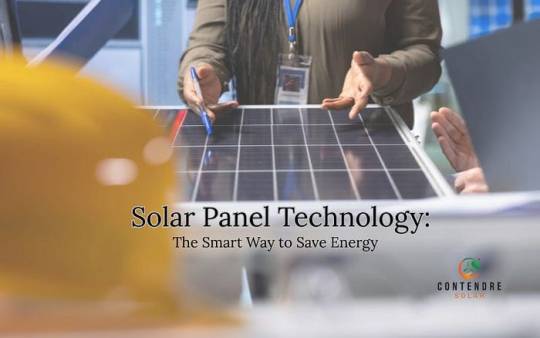
What Is Solar Panel Technology?
At the core of every solar panel are photovoltaic (PV) cells, usually made from silicon, a powerful semiconductor. These cells are designed to absorb sunlight and convert it into electrical energy.
Each panel contains several PV cells connected together and protected under a glass layer. When exposed to sunlight, these cells start a clean and efficient energy conversion process.
How Solar Panel Technology Converts Sunlight into Energy
Let’s simplify how solar panels work in four smart steps:
1. Sunlight Strikes the Panel
When the sun’s rays hit the PV cells, photons (light particles) knock electrons loose from the silicon atoms.
2. Direct Current (DC) is Generated
These freed electrons flow through an internal circuit in the panel, creating direct current (DC) electricity.
3. Inverter Converts DC to AC
Since homes and businesses use alternating current (AC), a solar inverter converts the DC power into usable AC electricity.
4. Powering Your Space or the Grid
Now that the electricity is ready, it powers your lights, fans, ACs, and other devices. If you generate more than you use, the excess energy can be:
Sent to the electric grid (on-grid system)
Stored in batteries (off-grid or hybrid systems)
Key Components of a Smart Solar Power System
Here’s what makes up a full solar energy setup:
Solar PV Panels — Capture sunlight and generate DC electricity
Solar Inverter — Converts DC to AC power
Mounting Structures — Holds the panels securely in place
Battery Storage (Optional) — Stores unused energy for later
Monitoring System — Tracks power generation and usage in real-time
Why Choose Solar with Contendre?
Contendre Solar delivers smart, affordable, and high-performance solar solutions for homes, businesses, and industries.
High-efficiency solar panels for maximum energy output
Customized on-grid and off-grid systems
Assistance with government solar subsidies and net metering
End-to-end installation, support, and maintenance
Reliable energy solutions trusted across India
Also : The Best Solar Panel Company In Maharashtra
Fun Fact!
A single solar panel can generate 250 to 400 watts of electricity per hour under direct sunlight. Imagine the power when you install a full rooftop system!
Clean Energy, Smarter Living
Solar panel technology isn’t just an innovation — it’s a lifestyle change that saves money, reduces your carbon footprint, and makes your home or business future-ready.
With Contendre Solar, you get more than just a solar system. You get a partner committed to making energy savings simple and sustainable.
Ready to Make the Smart Switch?
Contendre Solar is here to guide you from start to finish.
📍 Visit our website: contendresolar.com 📞 Call us today +91 91364 57555 📧 Email: [email protected]
Smarten up your energy with solar power by Contendre.
1 note
·
View note
Text
30% Faster ROI with Our Smart Solar + Pump Combo

⚡🌾 Solar + Pump Solutions – Harnessing the Sun to Power Your Water Needs Say goodbye to rising electricity bills and unreliable diesel engines. With our Solar + Pump Systems, you can draw water anywhere, anytime—powered entirely by the sun.
We provide complete solar water pumping solutions that are tailor-made for agriculture, irrigation, drinking water supply, livestock, and rural utility needs. Whether you’re farming in remote areas or managing water for commercial use, our systems offer a clean, cost-effective, and maintenance-free alternative to conventional pumping.
Our solution combines solar panels, smart pump controllers, and high-performance water pumps (surface or submersible)—creating a seamless setup that delivers water with zero fuel, zero emissions, and zero noise.
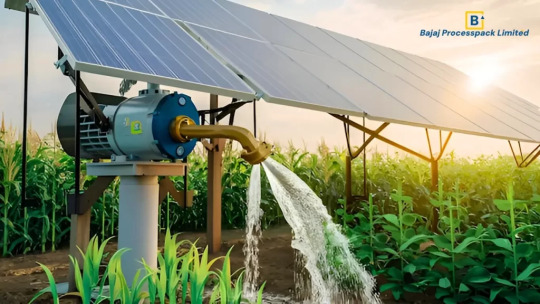
☀️ How It Works: Our system captures solar energy through high-efficiency PV panels and feeds it directly into an electric pump. The water is then pumped from borewells, ponds, rivers, or tanks and delivered to your farm or facility. With optional battery backup or hybrid design, the system can also work during cloudy weather or integrate with the grid if required.
🔧 Key Features: Available from 1 HP to 20 HP or more, depending on your needs
Works for deep borewells and open wells
Compatible with AC or DC submersible & surface pumps
Includes automatic dry-run protection and flow control
Optional remote monitoring system for live performance tracking
Built with ISI and MNRE-approved components
🌿 Benefits at a Glance: ✅ 100% renewable energy – No fuel, no electricity bills
✅ Eco-friendly – Zero emissions, low carbon footprint
✅ Minimal maintenance – Long-lasting, rugged systems
✅ Government subsidies available (varies by state)
✅ Proven performance even in tough weather
✅ Quick payback period due to energy savings
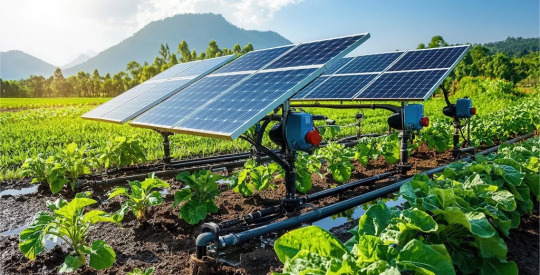
👨🌾 Ideal for: Farmers & cooperatives
Dairy farms and fishery units
Village water supply systems
Greenhouses and polyhouses
Government and NGO rural development projects
With increasing water demands and fluctuating power availability, solar-powered water pumps are not just a solution—they are the future. We make the switch easy, with full consultation, site assessment, installation, and after-sales service.
Empower your land with solar. Pump smart. Live sustainably.
📞 Call Now: [+91-120-4639950] 📧 Email: [[email protected]] 🌐 Website: [Bajajmachines.com]

#PampuJua#MajiJua#Umwagiliaji#KilimoJua#NguvuMbadala#TeknolojiaJua#KisimaJua#PampuMaji#UfanisiMaji#NishatiJua#MajiBilaUmeme#BilaDizeli#MajiSafisha#JuaKwaWakulima#GharamaChini#MashambaJua#PampuZaKuokoaNishati#MfumoWaUmwagiliajiKwaJua#SolarPump#SolarWater#Irrigation#SolarFarming#RenewableEnergy#SolarTechnology#BoreholePump#WaterPump#WaterEfficiency#SolarEnergy#WaterWithoutElectricity#DieselFree
0 notes
Text
How to Design Solar and On-off-grid Energy Storage Systems?
Solar on- off-grid energy storage systems are widely used in factories, commercial facilities and other places with large peak-valley price differences or frequent power outages. The system is composed of photovoltaic arrays made up of solar panels, combiner boxes, hybrid inverters, solar batteries, loads, power grids, etc. PV array converts solar energy into electrical energy under the condition of sunlight, supplies power to the load through a hybrid inverter, and charges the battery pack at the same time. The excess electricity can also be fed into the power grid. When there is no light, the load is powered by the power grid. When the power grid is out of power, the battery supplies power to the load through the hybrid inverter.Visit more
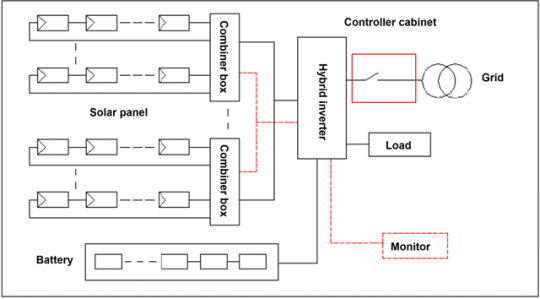
I. Main Components of the System
1.1 Solar panels
It is the main component of the solar power supply system and also the most valuable part in it. Its function is to convert the radiant energy of the sun into direct current electrical energy.
1.2 Hybrid inverter
The main functions are divided into two parts: the MPPT solar controller and the bidirectional DC/AC converter. Their role is to regulate and control the electrical energy generated by the solar panels charge the battery, and provide overcharge protection and overdischarge protection for the battery. At the same time, the direct current from the components and the battery is converted into alternating current for use by AC loads. When appropriate, the power grid can also charge the battery.
1.3 Solar batteries: Its main task is to store energy to ensure the power supply for the load when the power grid is cut off.
2. Main Components
2.1 Solar panels
Solar panels are solar power generation devices that directly convert solar energy into direct current electrical energy. According to the different requirements of users for power and voltage, solar panels can be made for individual use, or several solar panels can be connected in series (to meet voltage requirements) and parallel (to meet current requirements) to form a power supply array to provide greater electrical power. The power generation of solar cells increases proportionally with the increase of sunlight intensity. It slightly decreases as the surface temperature of the component rises. As the temperature changes, the current, voltage and power of the battery components will also change. When designing the components in series, the negative temperature coefficient of the voltage must be taken into consideration.

2.2 Hybrid Inverters
Three-phase solar hybrid inverter integrated machine, adopting the new generation of all-digital control technology, pure sine wave output; The solar controller and inverter are integrated into one, making it convenient to use. It is suitable for areas with power shortages and unstable power grids, providing an economical power supply solution. The product has the following advantages:
(1) Control hybrid inverter: Integrated solar controller and inverter, simple connection, convenient to use;
(2) High efficiency, with an efficiency of over 95%, maximizing the utilization of solar energy.
(3) High reliability: The inverter adopts power frequency design, has strong overload capacity, and is suitable for impact loads such as air conditioners.
(4) Comprehensive protection functions: Battery overcharge and overdischarge protection and advanced battery management functions extend the battery life. Overload protection, short-circuit protection and other functions ensure the safe and reliable operation of equipment and loads.
(5) The LCD liquid crystal screen provides intuitive display: monitoring of multiple working operation status parameters such as photovoltaic input voltage/current, AC output voltage/current, and battery capacity.
(6) The energy storage system is compatible with both lead-acid batteries and lithium batteries, providing users with multiple options.
(7) Various charging methods such as PV charging, mains (generator) charging, and hybrid charging, as well as multiple power supply methods including battery power supply and mains power supply.
(8) It supports multiple inverters running in parallel, making power expansion convenient.
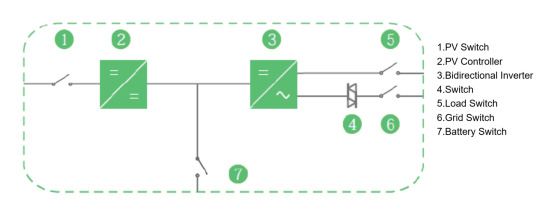
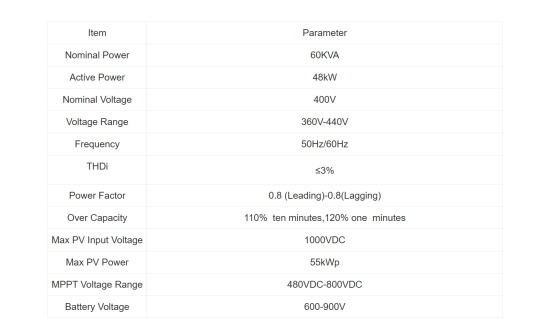
2.3 Solar Batteries
Solar batteries and related devices are an indispensable part of solar generation systems. They are mainly used to store electricity generated by solar energy and provide continuous power to loads at night, when there is insufficient sunlight or in emergencies. Common solar battery technologies include lead-acid batteries, alkaline batteries, supercapacitors and lithium batteries, each with different application ranges. Currently, the most widely used are lithium-ion batteries, especially lithium iron phosphate batteries (LFP), which perform well in solar systems due to their high safety, long life and excellent cycle performance. Since the advent of lithium battery technology in the 1980s, a variety of types have been developed, including ternary lithium, lithium iron phosphate, lithium titanate, etc.In this solution, we choose Brovolt 215 kWh lithium-ion battery cabinet.

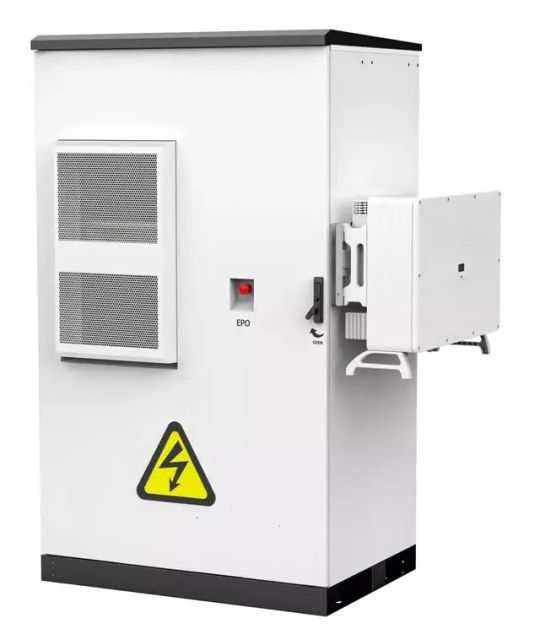
3.Solution design
Solar : monocrystalline 550W, quantity 100 pieces, 20 series and 1 parallel, total power 55kW.
Hybrid inverter: power 48KW
Lithium-ion battery cabinet: 215kWh.
0 notes
Text
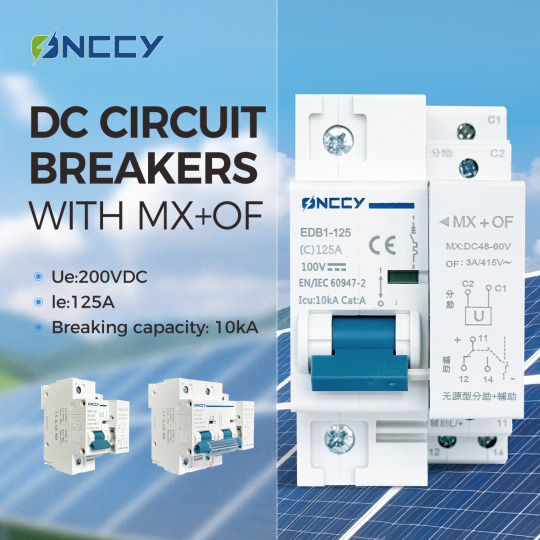
Revolutionary Upgrade: DC MCB + MX + OF Adds Two Core Capabilities • Millisecond Ultra-Fast Tripping: The shunt release (MX) instantly cuts off 800A fault currents upon command, enabling remote emergency shutdown for enhanced safety. • Real-Time Status Monitoring: The auxiliary contact (OF) accurately feeds back circuit status (ON/OFF), providing clear equipment visibility to enable predictive maintenance.
Dual-module synergy upgrades passive protection into an integrated high-reliability solution – combining active tripping and smart monitoring to build a robust safety loop for PV/energy storage systems!
[email protected] | +86 17301617015 www.onccy.com
#mcb#circuitprotection#mx#shuntrelease#of#auxiliarycontact#remotetrip#predictivemaintenance#pvsystem#energystorage#solarstorage#electricalsafety#smartgrid#faultprotection#energymanagement
0 notes
Text
Why Electrical Masters is the Best Solar Company for Solar Installation in Victoria
Are you looking for the best solar company in Victoria? When it comes to solar installation in Victoria, no one does it better than Electrical Masters. With years of experience, a 5-star reputation, and a commitment to in-house installation, we’re proud to be Victoria’s go-to experts in residential and commercial solar solutions.
Why Go Solar in Victoria?
Victoria is one of the most solar-friendly states in Australia. With generous rebates, high electricity prices, and abundant sunlight, now is the perfect time to make the switch to solar. By installing a solar system, you can:
Lower your power bills significantly
Increase the value of your property
Reduce your carbon footprint
Take advantage of Victoria's Solar Homes Program
But to truly maximise your solar investment, you need to work with a reputable, experienced, and transparent company—that’s where Electrical Masters comes in.
What Makes Electrical Masters the Best Solar Company in Victoria?
In-House Solar Installation Team
Unlike many companies that outsource, Electrical Masters has a fully in-house team of licensed solar installers and electricians. This means you get consistent quality, clear communication, and a faster turnaround time on your project.
5-Star Customer Reviews
We’re proud to be one of the top-rated solar companies in Victoria, with glowing reviews from happy homeowners and business owners alike. Our customers consistently highlight our professionalism, attention to detail, and ongoing support.
Premium Solar Products
We only use Tier-1 solar panels and industry-leading inverters to ensure you get long-lasting performance and maximum efficiency. Whether you're after a 6.6kW system, a 10kW solar system, or a battery-ready setup, we’ll tailor the solution to your energy needs and budget.
Transparent Pricing
No hidden fees. No confusing jargon. At Electrical Masters, we believe in transparent, competitive pricing. You’ll know exactly what you’re paying for—and what you’re getting.
Our Solar Installation Process in Victoria
When you choose Electrical Masters, you're choosing a hassle-free experience from start to finish:
Free Site Assessment & Quote – We inspect your property, evaluate your energy usage, and recommend a solar system that suits your needs.
System Design & Approval – We custom-design your system and handle all grid connection paperwork and rebates.
Professional Installation – Our certified in-house team installs your system safely and efficiently.
Ongoing Support – We provide monitoring support and aftercare, so you're never left in the dark.
Solar Rebates Available in Victoria
Victoria offers generous solar incentives that reduce upfront costs:
Solar Panel Rebate – Up to $1,400 off the cost of a solar PV system
Solar Battery Rebate – Up to $2,950 off eligible solar battery systems
Interest-Free Loans – Available to help you finance your solar investment
Electrical Masters can help you apply for these rebates and make sure you get the maximum benefit.
Residential and Commercial Solar Installation Victoria-Wide
We service all major areas across Victoria, including:
Melbourne & Greater Melbourne
Clyde North
Geelong
Mornington Peninsula
Gippsland
Ballarat and beyond
Whether you're a homeowner or a business owner, our team can deliver a reliable and cost-effective solar solution tailored to your site.
Ready to Go Solar with the Best?
If you're searching for the best solar company in Victoria or looking to start your solar installation in Victoria, Electrical Masters is here to help. Contact our expert team today to get a free quote and take the first step toward a cleaner, cheaper energy future.
📞 Call us | 🌐 www.electricalmasters.com.au | 📍 Victoria, Australia
0 notes
Text
Save Energy at Home: Smart Strategies to Reduce Bills

With energy costs rising across Australia (up 28% since 2021 according to Australian Energy Regulator), finding ways to save energy at home has become a priority for households nationwide. At REPARE Electrical & Air Conditioning, we help homeowners implement practical, cost-effective solutions that significantly reduce energy consumption without sacrificing comfort.
From simple behavioural changes to professional system upgrades, this comprehensive guide reveals how you can cut your energy bills by hundreds of dollars annually while reducing your environmental footprint.
Why Energy Efficiency Matters More Than Ever
Recent statistics show:
The average Australian household spends $1,645/year on energy (Energy.gov.au)
40% of home energy is wasted through inefficiency
Proper upgrades can save 25-50% on bills
Homes contribute 20% of Australia's carbon emissions
"Most families could save $400-$800 annually with simple changes and targeted upgrades," says Mark Wilson, Senior Electrician at REPARE. "The key is focusing on high-impact areas first."
Room-by-Room Energy Saving Guide
1. Kitchen: The Power Hub
Refrigerator:
Maintain 3-5°C (fridge), -15 to -18°C (freezer)
Clean condenser coils annually (saves 10-15%)
Upgrade to 4+ star models (save $140/year)
Cooking:
Use microwaves over ovens (70% less energy)
Match pot size to burner
Pressure cookers reduce cooking time
Dishwasher:
Run only when full
Use eco mode (saves 20%)
Skip heat-dry cycle
2. Living Areas: Entertainment & Lighting
Electronics:
Enable power-saving modes
Use smart power boards (save $100/year)
Unplug devices not in use
Lighting:
Switch to LEDs (save 85% vs halogens)
Install motion sensors
Utilise natural light
3. Bedrooms: Climate Control
Ceiling fans over AC (1/10th the cost)
Thermal curtains
Door snakes for drafts
4. Bathroom: Hot Water Savings
Low-flow showerheads (save $200/year)
Fix leaks promptly
Insulate pipes
HVAC: Your Biggest Energy Opportunity
Heating/cooling accounts for 40-50% of home energy use. REPARE's proven strategies:
Air Conditioning Efficiency
Set to 24-26°C in summer
Clean filters monthly (saves 15%)
Install zoning systems
Upgrade to inverter models (save 30-50%)
Heating Solutions
Reverse cycle AC most efficient
Seal ductwork (saves 20%)
Smart thermostat installation
"Our guide to save energy at home includes custom HVAC recommendations based on your home," notes Wilson.
10 Highest Impact Upgrades
Upgrade
Cost
Annual Savings
Payback Period
Solar PV System
$4,000-$8,000
$800-$1,500
3-7 years
Heat Pump Water Heater
$2,500-$4,000
$300-$600
5-8 years
Window Glazing
$3,000-$10,000
$200-$500
8-15 years
Insulation (Ceiling)
$1,200-$2,500
$150-$350
4-7 years
Energy Monitoring System
$200-$500
$100-$300
2-3 years
Behavioural Changes with Big Impact
Free Energy Savers
Wash clothes in cold water (save $115/year)
Dry clothes naturally
Close doors to unused rooms
Turn off lights when leaving
Smart Habits
Run appliances during off-peak
Use blinds strategically
Cook multiple meals at once
Defrost freezer regularly
Detecting Energy Vampires
Use an energy monitor to identify:
Old refrigerators (costing $200+/year)
Set-top boxes on standby
Gaming consoles left on
Outdated pool pumps
"Some clients discover one faulty appliance was adding $500 to annual bills," says Wilson.
Government Rebates & Incentives
Current programs include:
Small-scale Technology Certificates (solar)
Energy Savings Scheme (lighting, HVAC)
State-based rebates (VIC, NSW, QLD etc.)
YourHome.gov.au provides updated rebate information nationwide.
REPARE's Professional Energy Solutions
Our electricians and HVAC technicians provide:
1. Energy Audits
Thermal imaging
Appliance testing
Customised reports
2. Efficiency Upgrades
LED lighting retrofits
Smart thermostat installs
Solar system integration
3. HVAC Optimisation
Duct sealing
Refrigerant checks
Zoning systems
Case Study: Brisbane Family Saves $1,200/Year
Before:
1980s brick home
$2,800 annual energy bill
Old AC units running constantly
Our Solutions:
Installed 6.6kW solar system
Upgraded to inverter AC
Added ceiling insulation
Results:
Bills reduced to $1,600/year
4.5 year payback period
Increased home comfort
Seasonal Energy Saving Tips
Summer Strategies
Use fans first before AC
Close curtains during day
Grill outdoors to avoid oven heat
Winter Tactics
Let sunlight warm rooms
Wear layers before turning up heat
Use door snakes
Renters: How to Save without Renovating
Effective approaches:
Window insulation film
Portable induction cooktops
Smart power strips
Draft stoppers
Future Tech for Energy Savings
Emerging solutions:
AI-powered energy management
Transparent solar windows
Phase-change materials
Smart glass windows
Common Energy Myths Debunked
Myth: Leaving AC on all day is cheaper
Truth: Costs 20-40% more
Myth: Screensavers save energy
Truth: Modern monitors don't need them
Myth: Handwashing dishes saves energy
Truth: Efficient dishwashers use less
Take Control of Your Energy Use
Start saving today with REPARE's simple action plan:
Assess - Identify biggest energy users
Change - Implement behavioural fixes
Upgrade - Target high-ROI improvements
Monitor - Track savings over time
For personalised advice, download our complete guide to save energy at home or book an energy audit with our team.
Additional resources:
Energy Rating Calculator
Renewable Energy Info
Home Efficiency Tips
0 notes
Text
Save Energy at Home: Smart Strategies to Reduce Bills

With energy costs rising across Australia (up 28% since 2021 according to Australian Energy Regulator), finding ways to save energy at home has become a priority for households nationwide. At REPARE Electrical & Air Conditioning, we help homeowners implement practical, cost-effective solutions that significantly reduce energy consumption without sacrificing comfort.
From simple behavioural changes to professional system upgrades, this comprehensive guide reveals how you can cut your energy bills by hundreds of dollars annually while reducing your environmental footprint.
Why Energy Efficiency Matters More Than Ever
Recent statistics show:
The average Australian household spends $1,645/year on energy (Energy.gov.au)
40% of home energy is wasted through inefficiency
Proper upgrades can save 25-50% on bills
Homes contribute 20% of Australia's carbon emissions
"Most families could save $400-$800 annually with simple changes and targeted upgrades," says Mark Wilson, Senior Electrician at REPARE. "The key is focusing on high-impact areas first."
Room-by-Room Energy Saving Guide
1. Kitchen: The Power Hub
Refrigerator:
Maintain 3-5°C (fridge), -15 to -18°C (freezer)
Clean condenser coils annually (saves 10-15%)
Upgrade to 4+ star models (save $140/year)
Cooking:
Use microwaves over ovens (70% less energy)
Match pot size to burner
Pressure cookers reduce cooking time
Dishwasher:
Run only when full
Use eco mode (saves 20%)
Skip heat-dry cycle
2. Living Areas: Entertainment & Lighting
Electronics:
Enable power-saving modes
Use smart power boards (save $100/year)
Unplug devices not in use
Lighting:
Switch to LEDs (save 85% vs halogens)
Install motion sensors
Utilise natural light
3. Bedrooms: Climate Control
Ceiling fans over AC (1/10th the cost)
Thermal curtains
Door snakes for drafts
4. Bathroom: Hot Water Savings
Low-flow showerheads (save $200/year)
Fix leaks promptly
Insulate pipes
HVAC: Your Biggest Energy Opportunity
Heating/cooling accounts for 40-50% of home energy use. REPARE's proven strategies:
Air Conditioning Efficiency
Set to 24-26°C in summer
Clean filters monthly (saves 15%)
Install zoning systems
Upgrade to inverter models (save 30-50%)
Heating Solutions
Reverse cycle AC most efficient
Seal ductwork (saves 20%)
Smart thermostat installation
"Our guide to save energy at home includes custom HVAC recommendations based on your home," notes Wilson.
10 Highest Impact Upgrades
Upgrade
Cost
Annual Savings
Payback Period
Solar PV System
$4,000-$8,000
$800-$1,500
3-7 years
Heat Pump Water Heater
$2,500-$4,000
$300-$600
5-8 years
Window Glazing
$3,000-$10,000
$200-$500
8-15 years
Insulation (Ceiling)
$1,200-$2,500
$150-$350
4-7 years
Energy Monitoring System
$200-$500
$100-$300
2-3 years
Behavioural Changes with Big Impact
Free Energy Savers
Wash clothes in cold water (save $115/year)
Dry clothes naturally
Close doors to unused rooms
Turn off lights when leaving
Smart Habits
Run appliances during off-peak
Use blinds strategically
Cook multiple meals at once
Defrost freezer regularly
Detecting Energy Vampires
Use an energy monitor to identify:
Old refrigerators (costing $200+/year)
Set-top boxes on standby
Gaming consoles left on
Outdated pool pumps
"Some clients discover one faulty appliance was adding $500 to annual bills," says Wilson.
Government Rebates & Incentives
Current programs include:
Small-scale Technology Certificates (solar)
Energy Savings Scheme (lighting, HVAC)
State-based rebates (VIC, NSW, QLD etc.)
YourHome.gov.au provides updated rebate information nationwide.
REPARE's Professional Energy Solutions
Our electricians and HVAC technicians provide:
1. Energy Audits
Thermal imaging
Appliance testing
Customised reports
2. Efficiency Upgrades
LED lighting retrofits
Smart thermostat installs
Solar system integration
3. HVAC Optimisation
Duct sealing
Refrigerant checks
Zoning systems
Case Study: Brisbane Family Saves $1,200/Year
Before:
1980s brick home
$2,800 annual energy bill
Old AC units running constantly
Our Solutions:
Installed 6.6kW solar system
Upgraded to inverter AC
Added ceiling insulation
Results:
Bills reduced to $1,600/year
4.5 year payback period
Increased home comfort
Seasonal Energy Saving Tips
Summer Strategies
Use fans first before AC
Close curtains during day
Grill outdoors to avoid oven heat
Winter Tactics
Let sunlight warm rooms
Wear layers before turning up heat
Use door snakes
Renters: How to Save without Renovating
Effective approaches:
Window insulation film
Portable induction cooktops
Smart power strips
Draft stoppers
Future Tech for Energy Savings
Emerging solutions:
AI-powered energy management
Transparent solar windows
Phase-change materials
Smart glass windows
Common Energy Myths Debunked
Myth: Leaving AC on all day is cheaper
Truth: Costs 20-40% more
Myth: Screensavers save energy
Truth: Modern monitors don't need them
Myth: Handwashing dishes saves energy
Truth: Efficient dishwashers use less
Take Control of Your Energy Use
Start saving today with REPARE's simple action plan:
Assess - Identify biggest energy users
Change - Implement behavioural fixes
Upgrade - Target high-ROI improvements
Monitor - Track savings over time
For personalised advice, download our complete guide to save energy at home or book an energy audit with our team.
Additional resources:
Energy Rating Calculator
Renewable Energy Info
Home Efficiency Tips
0 notes
Text
Maximising ROI with Commercial PV Panels in Nottingham
As energy costs continue to rise and environmental concerns take centre stage, more companies are turning to solar panel installation in Nottingham as a long-term solution. Investing in commercial PV panels is not just about going green – it's also about boosting profits and reducing operational costs. Businesses in Nottingham and across the UK are now recognising the financial and environmental value of making the switch to solar panels for companies. This blog explores how solar for business can offer strong returns on investment (ROI), and what Nottingham-based companies need to consider before making the move.
1. Why Solar Energy Makes Business Sense
Switching to solar for business is a smart decision for many reasons. First, it significantly cuts down electricity bills. Businesses typically consume large amounts of power, and generating your own energy using commercial PV panels can lead to substantial savings over time.
Second, installing solar panels for commercial use can help businesses reduce their carbon footprint. This is not just good for the environment – it also enhances brand image and appeal to eco-conscious clients.
Finally, financial incentives like the Smart Export Guarantee (SEG) allow companies to sell surplus energy back to the grid, further improving ROI. By investing in solar panel installation Nottingham companies gain control over energy costs and benefit from long-term energy security.
2. Understanding Commercial Solar Panel Installation
Commercial solar installation involves fitting solar panels on a company’s roof or available land to generate electricity for business use. The setup includes commercial PV panels, inverters, mounting systems, and monitoring tools.
Nottingham has become a growing hub for renewable energy, and local providers make solar panel installation in Nottingham straightforward and efficient. From initial consultation to post-installation support, local installers offer end-to-end services tailored to commercial needs.
The installation process generally includes:
Site survey and energy assessment
Custom design of the system
Equipment selection and proposal
Installation and grid connection
Ongoing performance monitoring
When handled by experienced professionals, commercial solar installations can be completed with minimal disruption to daily business operations.
3. Key Factors That Influence ROI
To get the most out of your solar panels Nottingham installation, it's important to understand the factors that impact ROI:
Energy Usage: Businesses that operate during daylight hours will see faster returns because they use the energy as it’s produced.
Roof Space: More space allows for more commercial PV panels, increasing energy output.
System Size: A well-sized system ensures you maximise self-consumption while avoiding waste.
Incentives: Taking advantage of available tax breaks or government schemes can reduce upfront costs.
Maintenance: Well-maintained solar panels for companies perform better and last longer, which supports long-term ROI.
By considering these factors and working with knowledgeable providers, companies in Nottingham can make the most of their commercial solar installation.
4. Choosing the Right Solar Provider in Nottingham
Finding the right partner for your commercial solar installations is crucial. Look for a company with a proven track record in solar panel installation Nottingham and strong customer support. A good installer will offer:
A free site visit and tailored proposal
Guidance on financial options and payback period
Quality products with long-term warranties
Ongoing system monitoring and support
Don’t forget to check reviews and request case studies. Seeing how similar businesses have benefited from solar panels for commercial use can help you make a confident decision.
Conclusion Investing in commercial PV panels is one of the smartest ways businesses in Nottingham can save money, reduce emissions, and future-proof their operations. With the right system in place and a reliable installer, companies can enjoy years of energy savings and a strong return on investment.Have you thought about switching to solar? Or do you already use solar panels in Nottingham? Let us know your thoughts or experiences in the comments below – we’d love to hear from you!
0 notes
Text
Agricultural Solar Mounting Systems: A New Paradigm for Sustainable Land and Energy Development
Driven by global energy transition and agricultural modernization, agricultural solar mounting systems are emerging as an innovative solution to reconcile the contradiction between “land resource constraints” and “clean energy demand.” This model, which organically integrates solar power generation with agricultural production, achieves composite utilization of “power generation above panels and planting/breeding below” through modular bracket design, intelligent light control technology, and agricultural ecological collaboration. It paves a new path for the integrated development of modern agriculture and green energy.
System Architecture and Technical Core: Intelligent Design Balancing Power Generation and Farming The core of agricultural solar mounting systems lies in a “compatible” technical system. Their support structures typically adopt height-adjustable steel frameworks (generally 1.5-3 meters above the ground), which not only provide stable support for photovoltaic (PV) panels but also reserve sufficient light and ventilation space for crops below. For example, some systems are equipped with photosensitive sensors that automatically adjust the tilt angle of PV panels according to crop growth cycles, ensuring power generation while enabling crops to receive optimal light intensity. Additionally, integrated microgrid systems convert solar energy into electricity for direct use in farmland irrigation, greenhouse temperature control, or livestock shed power supply, reducing energy costs in agricultural production.
In planting scenarios, the system is particularly suitable for high-value cash crops (e.g., medicinal herbs, edible fungi) or shade-tolerant crops (e.g., strawberries, spinach). The shading effect of PV panels regulates local microclimates, reduces transpiration, and enhances water use efficiency. In livestock scenarios, PV panels provide shelter for poultry and livestock, while the land below can serve as pastures or breeding areas, forming a three-dimensional “PV + breeding” agricultural model.
Multidimensional Value: Triple Benefits for the Environment, Economy, and Agriculture Environmentally, agricultural solar systems significantly reduce carbon emissions—for instance, a 1-hectare PV agricultural park generates approximately 1.5 million kWh annually, equivalent to reducing 1,200 tons of CO₂ emissions while cutting energy consumption from fossil fuel-driven agricultural machinery. Economically, farmers can increase income through “land leasing + power generation revenue sharing,” with measurements showing that the comprehensive income per mu (0.067 hectares) increases by 30%-50% compared to traditional planting. Government subsidies for renewable energy projects and carbon trading mechanisms further enhance its commercial viability.
For agriculture, the system offers new approaches to address climate change. In arid regions, solar power directly drives drip irrigation systems, realizing integrated “power generation-irrigation.” In areas with abundant sunlight but poor soil, PV panel shading reduces soil moisture evaporation, improves crop growth conditions, and transforms “marginal land” into productive land.
Challenges and Prospects: Technological Iteration Driving Scalable Application Currently, the promotion of agricultural solar mounting systems faces challenges in costs and adaptability. Initial construction costs are high (approximately 20,000-50,000 RMB per mu), and customized designs are needed to accommodate different crops’ light and temperature requirements. However, with the 80% cost reduction in PV modules over the past decade and the integration of AI algorithms (e.g., light control based on crop growth models), the system’s economy and flexibility are gradually improving.
In the future, this model is expected to deeply integrate with smart agriculture—using IoT sensors to monitor crop growth and power generation data for collaborative optimization of “light-electricity-agriculture.” For example, the Netherlands has piloted combining agricultural solar systems with vertical farms, using PV power to drive LED lighting for indoor planting, increasing land use efficiency by over 10 times. This development path of “three-dimensional land use + localized energy” is becoming a key exploration direction for global sustainable agriculture.
Agricultural solar mounting systems represent not only efficient utilization of land resources but also the intersection of the energy revolution and agricultural modernization. They demonstrate that on limited land, humanity can achieve the dual goals of “producing food” and “producing energy,” providing an innovative and feasible solution for global carbon neutrality and rural revitalization.
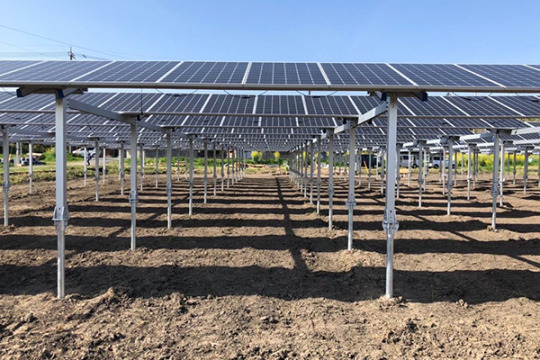
0 notes
Text
House Solar: Powering Your Home with Clean, Affordable Energy

As energy costs continue to rise and environmental concerns grow, more Australian homeowners are turning to house solar systems to power their homes sustainably and cost-effectively. Installing solar panels on your home not only helps reduce your electricity bills but also contributes to lowering greenhouse gas emissions, making it a smart choice for both your wallet and the planet.
What Is House Solar?
House solar refers to solar photovoltaic (PV) systems installed on residential properties. These systems convert sunlight into electricity that can be used to power your household appliances, lighting, and heating or cooling systems. Excess electricity generated during the day can often be stored in batteries for later use or exported to the grid.
Benefits of Installing House Solar
Lower Electricity Bills: By generating your own electricity, you reduce reliance on the grid and save money every month.
Energy Independence: Solar systems with battery storage provide backup power during outages and reduce exposure to fluctuating energy prices.
Environmental Impact: Solar power is clean and renewable, helping to reduce your home’s carbon footprint.
Increased Property Value: Homes with solar installations often sell faster and at higher prices.
Government Incentives: Rebates and incentives like the Small-scale Technology Certificates (STCs) lower the cost of installation.
How House Solar Systems Work
House solar systems primarily consist of:
Solar Panels: Usually mounted on your roof to capture sunlight and convert it into DC electricity.
Inverter: Converts DC electricity into AC electricity usable by household appliances.
Battery Storage (Optional): Stores excess energy for use during the night or cloudy days.
Monitoring System: Allows homeowners to track energy production and consumption in real-time.
Choosing the Right House Solar System
Factors to consider include:
Energy Consumption: Understand your household’s average electricity usage to size your system correctly.
Roof Orientation and Space: North-facing roofs with ample space receive the most sunlight.
Budget: Balance upfront costs with long-term savings and system size.
Installer Expertise: Work with Clean Energy Council-accredited professionals for quality installation and eligibility for rebates.
Why Choose Local Experts for Your House Solar Installation?
Local companies know the specific climate and regulatory environment of your area. For residents of the Gold Coast, Energy Solution Centre offers expert house solar system design, installation, and maintenance. Located at 19 Price St, Nerang QLD 4211, their team specialises in delivering tailored solar solutions that maximise energy generation and savings.
Call Energy Solution Centre at 1300 217 079 or visit energysolutioncentre.com.au to learn more and get a personalised quote.
Frequently Asked Questions About House Solar
Q: How much can I save with house solar? A: Savings vary based on system size and energy consumption but can be substantial over time, often paying back the investment within 5–7 years.
Q: Do I need a battery? A: Batteries increase upfront costs but offer energy independence and backup power.
Q: Is my house suitable for solar panels? A: Most homes with adequate roof space and sunlight exposure are suitable. A professional assessment confirms this.
Conclusion
Investing in house solar is a practical step toward energy savings, sustainability, and greater control over your electricity needs. By partnering with trusted local experts like Energy Solution Centre, you can ensure a quality installation tailored to your home’s unique requirements.For more information or to arrange a consultation, contact Energy Solution Centre at 1300 217 079 or visit energysolutioncentre.com.au. Power your home the smart, clean way with house solar.
#Solar Systems Qld#Commercial Solar Energy#Cost Of Solar Panels Qld#Solar Installation Companies#Solar Panels Companies#Solar Panels Company
0 notes